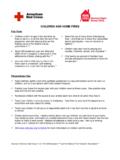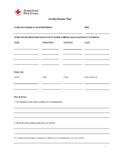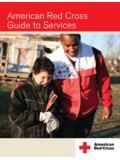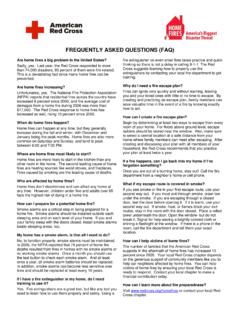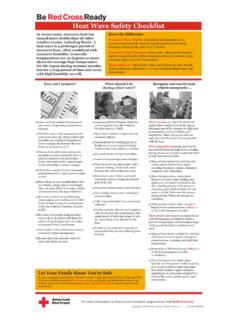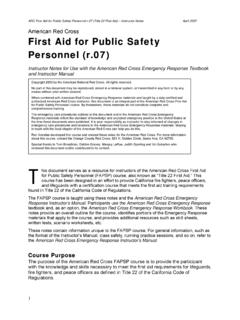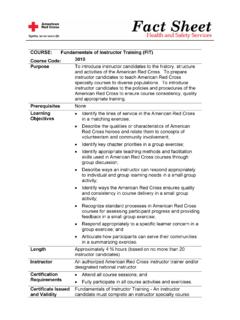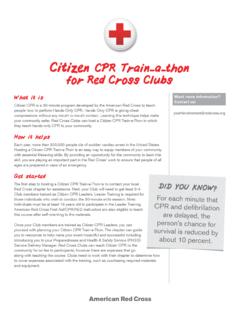Transcription of Water Safety Instructor’s Manual - redcross.org
1 Centennial EditionWater Safety instructor s Manual Chapter 3 | Planning and Conducting Effective and Safe Swim Lessons | 39 PLANNING AND CONDUCTING EFFECTIVE AND SAFE SWIM LESSONSOne of your responsibilities as an american Red cross Water Safety instructor is to make class time as safe, effective and rewarding as possible for your participants. This requires careful planning and preparation, especially when you consider what needs to be accomplished in the course session and during each lesson. For example, you need to plan how you will present aquatic skills and Water Safety information, and what activities you will do with your participants to help them learn new information and master new skills. In addition, you need to consider the variables that can affect each class, making no two classes the same. The information in this chapter will provide you with a framework for course planning, from developing a block plan to translating it into individual lesson plans.
2 Strategies for class organization, support and holding techniques, and flotation devices as teaching aids are also 3 SAMPLE40 | | Water Safety instructor s ManualpLaNNING a cOUrSe SeSSIONA course session consists of several lessons, or classes. When planning a course session, you can first create a block plan (a plan for the course session from beginning to end) and then use the block plan to create individual lesson plans for each class during the course to consider When planning a course SessionWhether you are preparing a block plan or converting that block plan into a daily lesson plan, there are several factors you need to take into account. Considering these factors in advance can help you to develop and conduct a safe and effective course session. First and foremost is Safety , for you and your participants. You must make every effort to prevent injuries. Be familiar with the facility s emergency action plan, and your role in implementing it.
3 Always make sure that a lifeguard is on duty and providing surveillance during any instructional periods. Be sure to explain, emphasize and enforce Safety rules, and never leave the teaching area until all participants are accounted for and have left the you have considered the strategies you will use to help promote Safety , consider factors related to the course session that you will be teaching. Ask yourself these questions: What are the requirements for the course session? How many classes are there per session? How long is each class? How many participants are enrolled in the course session? What equipment needs to be available? Are there any program-specific procedures and requirements that must be followed?Next, consider variables related to the participants. Ask yourself: Who are the participants and what are their goals for the course? How do the participants enrolled in the course session differ in terms of age, size, developmental level, skill level and learning style?
4 How can I communicate most effectively with each participant, taking into account the participant s age, developmental level, language or cultural differences, differences in ability and preferred learning style?Class size The number of participants in the class affects how long it takes to organize drills, practice the skills and give feedback to the group and to individuals. For example, you may need less time for each activity when the class size is small. When this is the case, you can plan for more activities per lesson. Small classes also allow for greater flexibility to include optional skills and other activities. Larger classes often require more planning to maximize participants Safety and participation. When the class size is large, consider using additional instructors or aides. Employing instructional methods such as station teaching or organizing drills using wave or stagger formations can help you to use class time more efficiently and Chapter 3 | Planning and Conducting Effective and Safe Swim Lessons | 41 Teaching Tip: Using co-instructors and instructor aides (see Chapter 1) can be an effective way to increase the amount of individual attention each participant receives.
5 When using co-instructors and instructor aides, be sure to defi ne their roles and responsibilities clearly before the class meets. This helps eliminate confusion and lapses in supervision. Remember, you are ultimately responsible for the Safety of all of your ability and readiness Developing block plans and lesson plans is easiest when all of the participants entering the course session have achieved the same level of prerequisite skills. However, this may not always be the case. If participants have a wide range of skills at the beginning of the course, you will need to develop a plan that challenges stronger swimmers while also offering opportunities for success for less advanced swimmers. A similar approach is needed when you have a participant with a disability or other health condition. The skills you will plan to teach depend on your initial evaluation of your participants abilities and readiness. Keep in mind that each skill prepares participants for more advanced skills.
6 As participants gain ease and confidence with a skill, you can introduce the next skill in the progression. COLA (Check Organize Lead Assess) is an approach that can help you plan effective lessons that meet the needs of your participants and help them to achieve their goals. Use the COLA approach (Box 3-1) at the beginning of a course session to establish a baseline and throughout the course session to track 3-1. cOLa (check Organize Lead assess) approach Use the COLA approach to establish a baseline for each participant at the beginning of the course session and to assess each participant s progress throughout the session. Using the COLA approach will help you plan lessons that help the participant build on existing skills and learn new to see what the participant is able to do, as well as the participant s willingness to try new skills. Is the participant able to perform a few skills in the level you are teaching?
7 If not, can she perform any skills from a previous level? Use the following questions and statements to guide this initial evaluation, which should take 1 to 2 minutes per participant: Can you do ___? Can you try to ___? Show me how to ___. Show me how you ___. Watch me and then let me know when you are ready to try. Watch me and then you your lesson plan based on the skills the participant has shown or expressed she is willing to try. Lead the participant by presenting skills that encourage participation, build confi dence and foster a willingness to try new skills. assess the participant s level of progress to help you plan the next lesson. You can conduct these assessments as part of a group activity or individually, depending on the make-up of the class. SAMPLE42 | | Water Safety instructor s ManualCourse completion requirementsWhen planning a course session, you need to consider what participants are expected to achieve by the end of the course, as well as the methods you will use to help them achieve those goals.
8 Strive to reinforce skills that participants have already been learned, in addition to introducing new of the courses in the american Red cross Swimming and Water Safety program progress from level to level, building upon previously learned knowledge and skills. Teaching from the known to the related unknown is a logical teaching method that helps to promote success. Reviewing previously learned skills helps to reinforce learning and ease the transition to learning new skills. In addition, you need to plan to address all required skills for the course session in some manner. Required skills for the various courses in the Red cross Swimming and Water Safety program are listed in Chapters 7 through 10 of this instructor s Manual . After you have introduced a skill, participants need to be given the opportunity to review and practice it in subsequent lessons until they are able to achieve the course completion requirements.
9 Time spent practicing and receiving immediate feedback following practice can increase Tip: To help track participants progress toward meeting the completion requirements for the course, download the appropriate skills checklist from instructor s Corner ( ) for each course that you teach prior to the fi rst a Block planA block plan (Figure 3-1) gives you a day-by-day overview of the course session across all lessons. By planning the main parts of your course from beginning to end, you set up logical learning sequences and ensure that all required Safety information and skills are included. One of the easiest ways to develop a block plan is to use a calendar approach. Each block is one day in the course. Include the following basic information in your block plan: Class level Day and time Number of participants Safety topic Review skills New skills Learning activities, including drills and games Equipment 2014 | Learn-to-Swim Level 3 Stroke Development | 1 Learn-to-Swim Level 3 Stroke DevelopmentDay 1 Day 2 Day 3 Day 4 Safety TopicllSwim as a Pair Near a Lifeguard s ChairSafety TopicllThink So You Don t SinkSafety TopicllToo Much Sun Is No FunSafety TopicllLook Before You LeapReview SkillsllExit skills assessment Level 2llFront crawl arm stroke and kicking drillsReview SkillsllBobs while moving toward safetyllJellyfish floatllFront crawl stroke drillsReview SkillsllJump into deep Water , return to surface, move onto back and floatllPush off streamlined, flutter kicking then swim front crawlReview SkillsllPush off on front.
10 Flutter kick and rhythmic breathing with kickboardllPush off on back and kick with elementary backstroke using kickboardllPush off on front and dolphin kickNew SkillsllBobs in chest-deep waterllFlutter kick with rhythmic breathingllPush off on front then begin flutter kicking with kickboardllTread Water using arm and leg actionsNew SkillsllFlutter kick drillsllSurvival floatllJump into deep Water , return to surface then swim back to wallllTread Water and move into back floatNew SkillsllPush off and glide on front in deep Water then move to a vertical position and tread waterllElementary backstroke kick drillsllPush off on back and swim elementary backstroke then recover to vertical positionllDolphin kick drillsllPush off on front and dolphin kickNew SkillsllRotary breathing drillsllPush off streamlined with flutter kicking then swim front crawlllElementary backstroke arm drillsllElementary backstroke coordinationllJump into deep Water , surface, rotate one turn, and swim front crawl to sidellHeadfirst entry from the side in a sitting positionGamellRed Ball.

